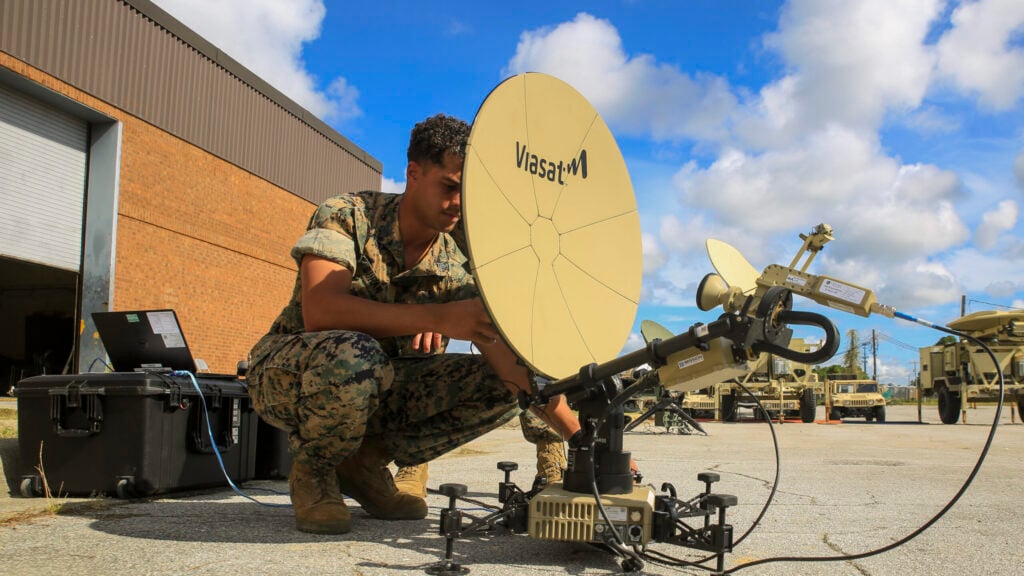
U.S. Marine Sgt. Gabriel Duran, a radio transmission operator with 2nd Marine Expeditionary Brigade, sets up a Viasat Multi-Mission Terminal on Marine Corps Base Camp Lejeune, N.C., Oct. 5, 2021. (US Marine Corps photo by Lance Cpl. Samuel Lyden)
WASHINGTON — After a successful pilot project, the Marine Corps has extended its contract with Viasat to provide satellite communications services — a deal that signals a sea change in how the Defense Department buys SATCOM, according to Viasat’s head of defense business.
“We’re starting to see a transition where the DoD and the services are starting to see the value of ‘SATCOM as a service‘. That’s a relatively newer way to deliver SATCOM. Previously, it wasn’t a managed service before, it was something you cobbled together out of terminals, and leased bandwidth and gateways, rather than a ‘buttoned-up’ service that we’re providing here,” Craig Miller, Viasat president of government systems told Breaking Defense Thursday.
Neither the Marines nor Viasat has released the value or duration of the new contract, but Miller said it includes “a mix of a few dozen different types of terminal, generally, deployable-slash-nomadic terminals that they can pick up and take with them wherever they go, and then set down again really quickly for setup.”
Miller said that the company is “very excited” by the expectation that Viasat’s SaaMs solution “will not only proliferate throughout the Marines for a longer duration and be a core component of what they do going forward,” but that the acquisition approach also will spread to other services.
For example, the Army also has launched a pilot program for SATCOM as a managed service, or SaaMS, working with the Space Force’s Commercial Services Office created in March 2022 — and Viasat will be participating in that effort as well, Miller said.
However, the Marine Corps program, which will supply its largest warfighting organization, USMC I Marine Expeditionary Force (I MEF), with always-on access to SATCOM, is being handled differently than the Army pilot. Rather than going through the Space Force’s Commercial Satellite Communications Office (CSCO) for contracting, the Marines have struck out on their own.
“We are in regular contact with USMC counterparts and do plan to observe how their implementation is executed. Observations may help inform use and business cases for the Army. Viasat is also keeping us updated with USMC progress,” an Army spokesperson told Breaking Defense in a Jan. 25 email.
Miller noted that Viasat supports the services desires and efforts to buy directly from commercial firms, but also is working closely with CSCO.
“We have a number of contracts through SF CSCO and we’re a provider to them,” he said. “The Space Force is generally trying to make it so that that office is a one-stop-shop, where the services and the components can go buy SATCOM. I think it’s a noble experiment to try to put it out there in a way that: Here’s where you go to get it, and it’s well publicized, and it’s well understood what you can get and how you can get it.”
This question of the balance of military and commercial SATCOM has been an issue of internal DoD debate for years. Up to now, to industry and congressional chagrin, DoD has tended to come down on the side of buying bespoke satellites (those it develops itself).
But DoD seemingly is now embracing commercial SATCOM providers, most recently with the release of a new Enterprise Satellite Communications Management and Control Implementation Plan touting a “hybrid, heterogeneous enterprise that uses the best mix of commercial and military solution.” The Space Force, led by CSCO and the Space Warfighting Analysis Center, also is now working to shift its acquisition strategy toward greater reliance on commercial soluations, in particular the use of SaaMS.
Commercial SATCOM providers have long urged DoD and the services to move from buying bandwidth in fits and starts using short-term contracts to service-style contracts that resemble a civilian’s average mobile phone or cable TV/Internet plan. Major SATCOM providers argue that this would not only ease problems with service gaps that have long plagued troops in the field, but also be cheaper and allow speedier integration of new technology.
“With the service, you only pay for what you use. It’s far more cost effective,” Miller said.
In addition, he explained the service model ensures that the customer “doesn’t have to pay for upgrades to the network and enhancements to the cybersecurity and efficiencies of the network.”
Finally, for the individual end user — i.e., the troops in the field — the advantage is ease of us, in that the terminals provided are “plug and play” and don’t require any configuration by the operator.
Miller said that in the SATCOM commercial sector, managed service buys are already the trend, and that he believes it is also going to happen for the US military.
“There’s been a tremendous amount of momentum in that direction over the last five years, and I think basically all commercial SATCOM providers are realizing that that’s the most economical and feature-rich way to provide SATCOM services. It’s best for the users and it’s best for us too. And so that’s the future of SATCOM,” he said.
Move over FARA: General Atomics pitching new Gray Eagle version for armed scout mission
General Atomics will also showcase its Mojave demonstrator for the first time during the Army Aviation Association of America conference in Denver, a company spokesman said.


























